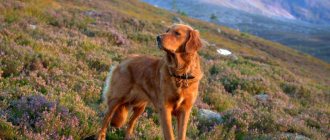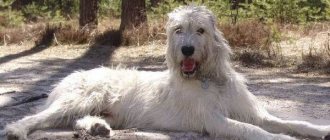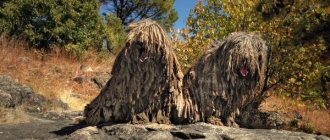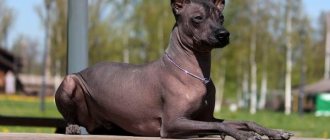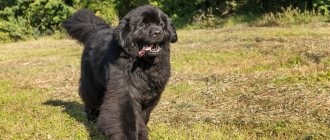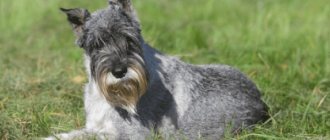There is something special about the Nova Scotia Retriever. Originally called Little River Duck Dogs, these water-loving, athletic, family-friendly pups look like standard retrievers, just a little smaller, but with a personality that's hard to find in other similar breeds.
Whether this personality will bring joy or stress to your life depends on what you expect from a family dog and what kind of lifestyle you can offer these feisty balls of fur.
Nova Scotia Duck Tolling Retrievers (often shortened simply to Tollers, for obvious reasons) are an athletic breed with traits of intelligence and affection and a penchant for independence.
Give your Toller what he needs, including plenty of exercise and attention, and you'll have a loyal, loving companion plus a partner for hikes, bike rides, and every long walk your legs can handle.
Characteristics of the Nova Scotia Retriever
| Attachment level | High |
| Friendliness | High |
| Child friendly | High |
| Loyalty to other pets | Medium-High |
| Exercise needs | High |
| Playfulness | High |
| Energy level | High |
| Learning ability | Medium-High |
| Intelligence | High |
| Tendency to bark | Medium-High |
| Shedding amount | High |
Breed standard
The Nova Scotia Retriever has a powerful frame with well-developed muscles, and its movements are decisive and dexterous. With a height of up to 53-54 cm, males weigh up to 23 kg. The height of bitches can reach 50.5 cm, and weight – up to 20 kg. Puppies of this breed grow and mature until they are one and a half years old.
The head is wedge-shaped, the forehead is rounded and wide, the stop is pronounced, but not sharp. The jaws are developed and wide, the lips fit tightly to each other, the teeth have the correct bite. The pigmentation of the nose is black, but brown and light shades are also acceptable.
It is important that they are in harmony with the color of the dog. The dog looks at the world with wide-set, almond-shaped, intelligent eyes. Triangular ears fit tightly to the skull, their tips are rounded.
A balanced body visually resembles a rectangle. The chest is deep and voluminous, the back is level, the sloping croup is well developed. The tail is carried just below the horizon. Thick at the base, it tapers towards the end. In a state of excitement, it can be higher than the spine, but it never falls over onto its back.
The dog has a thick, elastic coat and an undercoat that has water-repellent properties. The hair structure is most often straight; on the ears and tail the hair can lie in waves. As for colors, they vary widely, from light beige to rich brick. There may be white markings on the tail, paws, chest and muzzle.
History of the Nova Scotia Retriever
The Nova Scotia Retriever originates from Yarmouth County in Nova Scotia, a Canadian coastal province located slightly northwest of Maine. Originally bred by hunters in the 19th century, tollers have long been renowned for their ingenuity in hunting.
Like the fox, the Nova Scotia Duck Retriever uses quick movements that attract the attention of prey and lure it into the open. And since they are, of course, retrievers, they are valuable to hunters for their willingness to enter the water and bring back downed waterfowl.
Tollers remained a secret among Nova Scotia hunters for many years, although they were eventually recognized by the Canadian Kennel Club in 1945 (the occasion marked the official renaming of the breed from Little River Duck Dogs to their current long-winded nickname).
Modern dogs, while still looking and acting like foxes, have adapted well to life outside of hunting—although many are still active in the sport. Today they are happy to live the life of a family dog, as long as they still have an outlet for their proverbial retriever drive.
Kinds
The Nova Scotia Toller Retriever belongs to the group of hunting dogs whose task is to find and bring a shot bird to its owner. High intelligence, endurance, and versatility in use unite duck representatives with other varieties of retrievers. In total, according to FCI parameters, 6 species are distinguished, including the “duck” hunter:
- Labradors;
- Nova Scotia Retrievers;
- straight-haired;
- Chesapeake Bay;
- golden;
- curly-haired.
The work of Canadian hunters on the breed brought recognition to the Nova Scotia Toller on an equal basis with its larger relatives. Sometimes the “duck” representative is confused with the golden retriever, which has a very gentle disposition that makes it possible to make guide dogs out of them.
Caring for a Nova Scotia Retriever
Like most dogs, this retriever requires daily exercise to be at its best. One or two long walks or a fenced-in backyard. which is necessary, although Tollers also like to actively engage in sports.
Ultimately, a given pet's exercise needs will vary depending on their personality, with some being content to lounge on the couch for most of the day if they've had a good walk, while others require much more stimulation and activity.
Training a Nova Scotia Retriever can be a challenging task. They are certainly eager to please their people, but have a stubbornness and independent streak that can make it difficult to practice effectively.
Experts recommend short training sessions combined with lots of praise and encouragement. And since some Tollers are prone to mischief, the breed requires some basic obedience training to curb this behavior.
When it comes to grooming, grooming requirements for the Nova Scotia Retriever are similar to other retrievers: regular brushing, with more frequent brushing during the shedding season. Like all dogs, you need to regularly brush your teeth, trim your nails and clean your ears.
Nutrition
The health of your pet depends on a proper and balanced diet. The owner of a toller needs to feed the animal with natural products or dry food, which is taught to him at a tender age.
The composition of foods in the diet should include:
- meat;
- sea fish;
- various cereals;
- fruits vegetables.
The Nova Scotia Retriever is not prone to allergies. The amount of food needs to be controlled, since the toller tends to overeat. It is forbidden to give legumes and chicken bones - they cause irreparable harm, especially to young puppies.
Ready-made diets are selected for the category of hyperactive, medium-sized dogs. Mixed meals are not allowed. Fresh water in a bowl is required.
An adult dog needs 1-2 feedings per day. Puppies are fed up to 5 times a day. Babies begin to add porridge to their diet at 2 months of age. Then meat is included in the diet. The volume and variety of natural food is gradually increasing. By the age of 1.5 years, Nova Scotia Retriever puppies eat like adult dogs.
General health problems
All purebred dogs can be susceptible to certain genetic diseases. While these retrievers are considered generally healthy dogs, be aware of the following diseases that can affect this breed:
- Addison's disease
- Deafness
- Collie eye abnormality
- Progressive retinal atrophy (PRA)
- Hip dysplasia
Some of these diseases, such as Addison's disease and deafness, do not typically appear in the breed until middle age, meaning that a puppy with these genetic defects may be bred before the diseases are detected (unfortunately, genomic marker tests not yet available for the breed).
If you are purchasing a puppy, ask if any diseases have been found in the line. A good breeder will not breed a dog that can spread these diseases.
Although it is impossible to prevent all cases of the above or other diseases, it is necessary to take appropriate measures to reduce the risk.
Price
The cost of rare breed puppies is always high. In Russia, duck retriever dogs number only a few dozen specimens. You can find out about buying a pet at the nursery in St. Petersburg. The price of a Nova Scotia Retriever depends on the class of the puppy, starting from 45,000 rubles. Buying a pet for exhibition purposes will cost twice as much.
Many factors influence the cost:
- breed qualities of the parents;
- age and condition of the puppy;
- ancestor titles, pedigree;
- status of the nursery itself.
In the CIS countries and European countries, the cost of purebred puppies is in the same price range. Buying a baby Toller is a responsible and expensive undertaking. The owner must realize that a rare breed will show its best only in a home where the puppy is loved, raised, given time, and cared for.
How and what to feed a Nova Scotia Retriever
The Nova Scotia Retriever's nutritional needs are the same as most dogs, and a high-quality food with plenty of protein is best. It is advisable to take into account the specific dietary needs of the puppy and adult dog. Feel free to give your pet plenty of healthy treats (remember: they respond well to positive reinforcement!) and talk to your veterinarian if you have any questions or notice that your dog is gaining too much weight.
pros
- Does not require much care
- Friendly to dogs and children
- Likes to play sports and active games
Minuses
- Not very suitable for apartment living
- Sheds quite a bit
- Not suitable for households with cats
Care and maintenance
Due to its small size, the Nova Scotia Retriever breed can live in an apartment, but requires active walks, necessary physical activity, and work. Living in a private house, a large yard, or a free enclosure will give the dog more space, but it is important to provide sufficient attention to the sociable animal. Keeping a Nova Scotia Retriever on a chain is absolutely unacceptable.
Owners need to take into account the active molting of tollers, their predilection for wallowing in mud, and swimming in puddles. Fans of cleanliness and people prone to allergies will find it difficult to maintain a Nova Scotia Retriever.
The key to a wonderful coexistence between dog and owner will be playing together, traveling, and walking. The owner needs to ensure proper upbringing of the toller, otherwise the natural activity will make the animal uncontrollable in chasing cats and not accepting strangers.
Tollers love traveling and active walks.
The dog trains well, although he is characterized by a certain stubbornness. An excellent result of training is the dog’s ability to wait for its owner, show patience, and protect from offenders, despite its modest size.
A toller can become the pride of its owner if it takes part in dog competitions or duck hunting. The pet constantly needs communication. If there is a second dog in the house, then they will make a wonderful pair for playing while the owner is busy.
Proper care consists of the following procedures:
- regular combing and cleaning of the coat (at least once every 3 days) with a wide-toothed comb;
- trimming nails no more than once every 1.5 months - wear occurs during active walks;
- bathing as needed without shampoos that affect fiber lubrication;
- receiving vaccinations that protect against infection when interacting with other animals.
Washing with special products and conditioners is allowed once every 1.5-2 months for pets; street dogs are bathed twice a year. A dog has a neat appearance if it has no tangles, clean ears, and clean skin.
Dogs admitted to exhibitions receive special care. A light haircut allows your pet to look stylish. You can’t be overzealous with your hairstyles—at exhibitions, the most natural look is valued.
Dog owners are well aware of the sonorous voices of tollers. They are not silent people - they express joy or anxiety by barking. Upbringing can slightly moderate the violent expression of feelings; devoted friends are simply forgiven a lot.
Training requires patience. Game methods bring satisfaction from communication and results. At one year of age, the puppy should know basic commands; later they will be taught hunting wisdom. If you have no training experience, you need the help of a professional dog handler.



